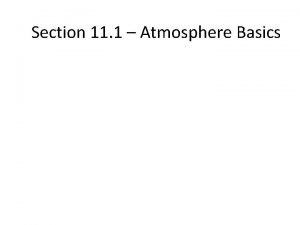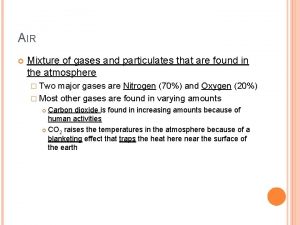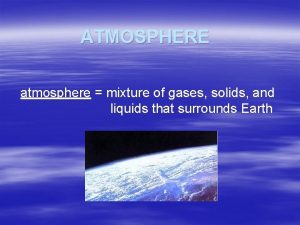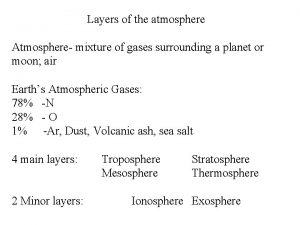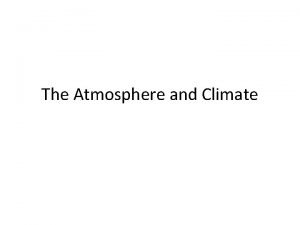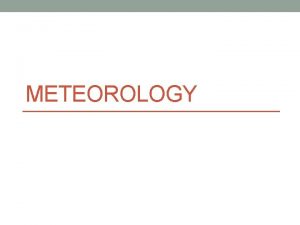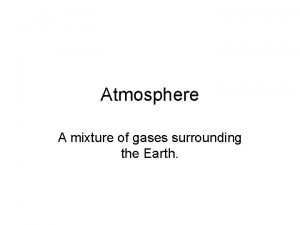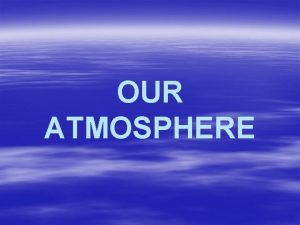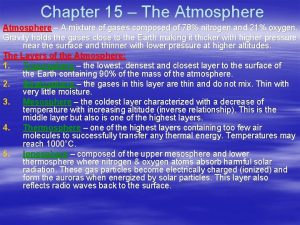The atmosphere is a mixture of several gases












- Slides: 12


The atmosphere is a mixture of several gases nitrogen being predominant. The atmosphere also contains oxygen which is vital to all living creatures. It also contains dust particles which help in the formation of rain drops. We are protected from the ultra-violet rays emitted by the sun by the ozone layer

The atmosphere extends to nearly 1600 kms from the surface of the earth. It is dense near the surface. The density of air decreases as we go further up from the surface of the earth. The atmosphere is divided into five parallel zones They are ; 1. Troposphere 2. Stratosphere 3. Mesosphere 4. Thermosphere 5. Exosphere

This is the lowest layer of the atmosphere with an average height of 12 km. In this layer, the temperature decreases at the rate of 1 c for Every 165 meter. This is called the ‘lapse rate’ it is due to this phenomenon that the mountain peaks always remains cool. Clouds, fog, snow fall, and rainfall occur in this layer 0

The stratosphere lies above the troposphere and extends up to 50 kms from the earth’s surface. Temperature is almost constant in this layer.

Thermosphere extends from 90 -500 kms. Due to the intense heat, oxygen and nitrogen atoms get ionised. Due to ions, radio waves get reflected to the earth. As a result of this, one can watch T. V and listen to radio. Mobile communication is also possible because of this layer. Due to the presence of ions it is also called IONOSPHERE.

The exosphere is also known as the magnetosphere. It is the outer most layer of the atmosphere. it contains only traces of atmospheric gases.

The sun is very chief source of heat. The earth is about 150 million kms from the sun, and hence the earth receives little insolation. About 37% of sun’s energy is lost by reflection from the clouds and dust particles. Another 6% is absorbed directly by the gases in the upper atmosphere. Thus the remaining 57% reaches the earth.

Based on the solar radiation, the surface of the earth can be divided into 3 different zones: 1) Torrid zone 2)temperate zone 3)frigid zone

The torrid zone extends on both side of the equator up to the tropic of cancer in the north and tropic of Capricorn in the south. This is the hottest zone. Mild winter are its feature. Hence the Greeks described this zone as ‘Winterless tropics’.

This zone extends from 23. 5 dc to 66. 5 dc in both the hemisphere. Warm summer and cold winter are its marked feature. It is also known as an intermediary zone.

The frigid zone extends from 66. 5 to 90 on both sides of the equator. This zone is characterized by mild and short summer long and
 The atmosphere is a mixture of ___________.
The atmosphere is a mixture of ___________. Atmosphere basics
Atmosphere basics Air mixture of gases
Air mixture of gases Is windex homogeneous or heterogeneous
Is windex homogeneous or heterogeneous Thế nào là hệ số cao nhất
Thế nào là hệ số cao nhất Diễn thế sinh thái là
Diễn thế sinh thái là Vẽ hình chiếu vuông góc của vật thể sau
Vẽ hình chiếu vuông góc của vật thể sau Lp html
Lp html 101012 bằng
101012 bằng Lời thề hippocrates
Lời thề hippocrates Vẽ hình chiếu đứng bằng cạnh của vật thể
Vẽ hình chiếu đứng bằng cạnh của vật thể Chụp phim tư thế worms-breton
Chụp phim tư thế worms-breton đại từ thay thế
đại từ thay thế

